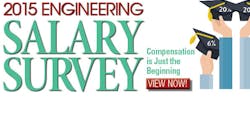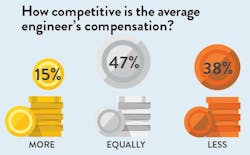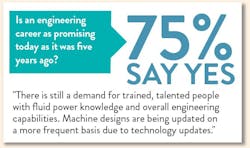Nearly 1,700 members of the fluid power industry participated in the first Hydraulics & Pneumatics Salary Survey to provide input and answer questions that reflect the status of the industry as a whole. While the majority of the sample is made up of engineers (most of them R&D, project and design engineers), it also includes other professionals such as engineering managers, executives, and vice presidents of engineering.
Overall, fluid power professionals are satisfied in their current positions, welcoming the industry’s intellectual challenges with open arms and taking pride in their design solutions. More than three-quarters of workers think that the potential for salary advancement is as promising now as it was five years ago and the majority would recommend a career in fluid power to the aspiring engineer. The base salary of the average worker is approximately $92,000, which measures slightly higher than last year’s reported salary, and the majority of employees feel adequately compensated for the work they do.
When asked about the future of the industry, participants note that a shortage of fluid power experts calls for bright new minds, especially as older generations retire. Most agree that fluid power systems will likely remain ubiquitous in most heavy-duty machines, infrastructures, and systems, so there will always be a need for personnel.
Respondents also stressed the necessity for a high-level understanding of fluid power systems and technologies in the emerging workforce. New hires are expected to know how to troubleshoot, understand controls and manufacturing, and come prepared with hands-on experience. Some commenters claim that there is a lack of focus on fluid power in most college engineering programs, but that good programs are still available to prepare them for successful careers in fluid power. These professionals further recommend that aspiring fluid power engineers gain a firm handle on electronic controls, PLCs, and software, since these technologies seem to be advancing in the industry.
Watch our editors discuss the results of this year’s surveys, courtesy of Engineering TV:The survey results also reflect the fluid power engineer’s commitment to keeping up with current technology. Respondents say they rely mostly on engineering and technology publications, as well as webcasts, seminars, trade shows, and conferences to continually educate themselves on changes in the industry. Companies also invest in the knowledge of their employees, reimbursing mostly for seminars, trade shows and conferences, college tuition, and certifications.
When it comes to outsourcing, most jobs are subcontracted to other companies in the U.S. The main reasons for outsourcing are lack of in-house talent and specialty skills; to save money, resources, and time; and to ease the workload.
Leah Scully, associate content producer at Hydraulics & Pneumatics, wrote this report. Data conducted and compiled by Jay McSherry.





